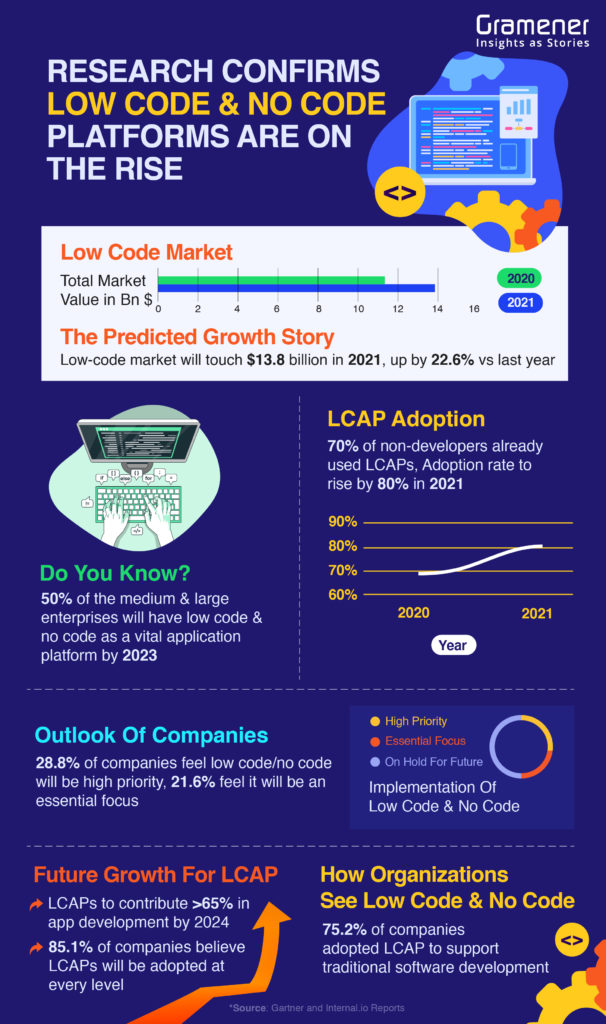Whenever we come across a feature-rich custom web app or mobile application, we go in awe of it. But do we realize how much time and effort goes behind coding them? Coding is not easy and is time-consuming and resource-consuming. But what if we tell you that a better alternative exists that can still help you get the same results? Well, the answer is low-code and no-code development platforms.
With stakes being so high, you should not miss out on knowing about the technology. In this article, we feature low-code and no-code development platforms and how they can be beneficial for you.
Find out the trends, benefits, scope, and use cases of low code development
Download Free Ebook
Table of Contents
Gartner’s View on Low-Code and No-Code Platforms
According to Gartner, the low-code development market will touch $13.8 billion in 2021, increasing by 22.6% compared to the previous year.
So, what is the difference between low-code and no-code?
According to Gartner, a low-code application development platform (LCAP) offers rapid application development, single-step deployment, execution, and management. All of this with the help of metadata-based and model-driven programming languages.
When it comes to no-code application platforms, Gartner defines that they are similar to low-code application development platforms. They require only text entry for simple expressions or formulae. So, the no-code platforms are pretty much a part of the LCAP market.
When we talk of citizen development, no-code platforms do not meet the requirement. The configuration tasks might not require codes, but they need specialist skills. It can thus confuse anyone about low-code and no-code development platforms.
Gartner, in 2021, released a report titled, ‘Magic Quadrant for Enterprise Low-Code Application Platforms.’ It had a criterion where platforms with no-code capability got included.

Gartner explains in the report that it is possible to solve existing challenges related to code-based applications with LCAPs. They allow quick creation and deployment of applications.
Are Low-Code and No-Code Platforms the Future of App Development?
Indeed, low-code and no-code in the future of application development. Low code no-code platforms are making it easy for enterprises to launch their apps in no time.
According to Gartner’s estimates, more than 50% of the medium and large enterprises will have low-code and no-code as one of their vital application platforms by 2023. They further estimate that LCAPs will contribute more than 65% to the development of applications by 2024.
The pandemic has already put pressure on most organizations to accelerate digital transformation at workplaces. Low-code and no-code platforms will also help bring a level-playing field for application development for small and big businesses. Advanced tools and the best talent in the market have always remained restricted to companies that can afford to splurge. That will be a story of the past with the advent of low-code and no-code platforms.
What is Low-Code Development?
Low-code platforms are ideal for developers to design applications without worrying about coding. In case you are wondering what is low code used for, it can create applications by simply dragging and dropping visual blocks of existing code. All of that goes into a workflow.
Creating applications with low-code platforms is much like developing them traditionally. The main difference is the number of shortcuts and ease of use LCAPs offer. As a developer, you do not have to understand the latest frameworks or write multiple tests before a single line of coding. You can instead get directly started with creating your application.
Advantages of Low-Code
There are several benefits when it comes to low-code development platforms. Here is a list of each of them.
- Speed: You can get started immediately with designing applications and can even build for multiple platforms at once. It is also possible to keep all the stakeholders informed about the daily progress.
- No risks: LCAPs have robust security measures, data integration, and support across platforms. You can also customize them based on your business needs. You can work on the platform without worrying about risks.
- Efficiency: Your developers can get done with a project without spending much time. It will lead to freeing up resources that you can utilize for other projects in the pipeline.
- Single-click deployment: You can send your application to production with a single click. It will help you get rid of all your application launch worries.
Limitations of Low Code
While there are several advantages of LCAPs, there are some limitations as well. Let’s take a look at what they are.
- Learning curve: If you are not familiar with the world of application development, it might take some time for you to get accustomed.
- Advanced capabilities: Low-code platforms enable the quick development of applications. However, they might fall short of creating enterprise-level applications. Scalability might also be an issue.
What is No-Code Development?
Just like LCAPs, no-code development platforms also have drag-and-drop functions and visual development. These platforms are ideal for people who want to design applications for specific use cases. It is the easiest route for businesses to get applications developed without bothering about getting onboard professional developers.
Tools that developers need to create feature-rich applications are already available for use. The platform is much like e-commerce websites and platforms offering pre-built templates and pages.
Advantages of No-Code
Here are the advantages of no-code development platforms.
- Quick development: No-code platforms enable rapid development of applications rather than the three to six months that it usually takes for traditional development.
- No training: There is no need for any formal training to work on no-code platforms, enabling anyone to work on them.
- Solve immediate challenges: Businesses can solve their immediate problems without letting them affect their long-term projects.
Limitations of No-Code
Here are some limitations of the no-code development platforms.
- Shadow IT: People can create applications without appropriate considerations and supervision by domain experts.
- Concerns: When there is a lack of formal guidance, it can lead to issues related to integration, compliance, and security.
Will Low-Code Replace Developers?
The concept of citizen development has gathered a lot of traction in the last few years. And why not? LCAPs are here to simplify the process and shorten the time required to create applications. The simple drag and drop functions of low-code and no-code platforms enable anyone to create applications without coding knowledge.
Similarly, other essential functions of LCAPs like prebuilt templates and visual modeling tools are all here to offer a seamless experience in application development. According to a survey, 70% of businesses said their non-developers have already used LCAPs to create tools for internal use. The trend is likely to continue in 2021, with 80% of them expected to adopt low code and no-code platforms.
Low code and no-code platforms are not here to replace traditional engineers and make them redundant. Instead, these platforms will only help them get rid of mundane tasks and focus on something that delivers more value. It could lead to better resource utilization and innovation.
Also Read: Key differences between low code and traditional development
👉 It is expected that the concept will likely face resistance from traditional developers. According to the same survey, 69.2% of respondents felt that engineering teams might get affected by citizen developers.
👉 75.2% of companies in the survey had adopted low code and no-code platforms to complement their traditional software development. So these tools are here to make life easier instead of making traditional developers redundant.
👉 The survey further finds that 28.8% of respondents feel low code and no-code will become a high priority. For 21.6%, it will be an essential focus. As many as 85.1% of respondents felt that LCAPs will become common across their companies. So the low-code no-code market map looks very bright, to say the least.
Low-Code Vs. No-Code: When Can Enterprises Use What?
When you contemplate choosing low code and no-code platforms, keep in mind that both are designed for speed. But it might be confusing to use what and when. Let’s figure that out based on some parameters.
- Use cases: LCAPs are ideal for creating standalone applications and portals that need integration with data sources and systems. Here are some low code use cases that even Gartner recommends to enterprise solution builders. You can do it for almost everything except scenarios where you need sophisticated systems that require multiple backends and extensive data sources. No-code platforms are suitable only for front-end systems.
- Business needs: No-code platforms meet the needs of micro, small, and MSME businesses well. LCAPs are best suited to cater to enterprise needs.
- Customization: Low code and no-code platforms are both a better option to design applications that require little customization. These platforms help you create responsive and user-friendly applications much faster than traditional means of development. As LCAPs also require some minimal coding, developers working here will ensure there are no security or compliance issues.
- Additional functionalities: No-code platforms fall behind LCAPs if you want to get additional users onboard for further action, add them to different nurturing flows, or shift the feedback data to CRM.
What Are the Top Low-Code Platforms?
With the advent of LCAPs, several vendors have been offering sophisticated and intuitive tools. At the same time, it is also essential to learn about tools that are not worth your time and money. So how do I choose a low code platform that suits my business needs can be a common question.
Different tools are designed to solve different purposes based on varied requirements. So, what works for others might not necessarily work out for you.
Read our detailed analysis on the best low code platforms for enterprises and compare them based on their features, pricing, and competitors. Some of the most popular low code platforms to build data applications, mobile applications and more are:
Bottomline
Low code and no-code development platforms are here to stay as they have a bright future. They will not replace the traditional method of software development, but will only complement it. Businesses can leverage these platforms to help their developers work on meaningful tasks and generate better results.
At Gramener, we have a low-code development platform, Gramex, that helps to create enterprise-level data and AI applications and solutions. Want to know more details about the tool?
Contact us today for a quick demo of how the tool works.


